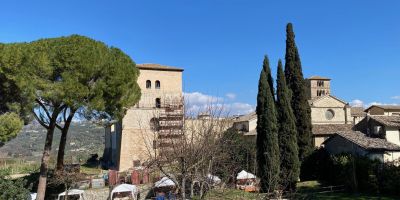Named for the Farfa River, a tributary of the Tiber flowing nearby, Farfa is the site of one of the most significant monuments of the late Middle Ages in central Italy, the Abbey of Farfa.
The first edifice of the Benedictine Abbey of Farfa appears to have been constructed in the sixth century A.D. on the site of a pre-existing Roman villa of the second century A.D. A 9th century text indicates the founder as San Lorenzo Siro, who fled persecution in Syria with a small group of monks.
San Lorenzo Siro’s abbey was destroyed by the Longobards and rebuilt in the late eighth century by another pious monk, Tommaso da Moriana, following a vision of the Virgin Mary. During San Tommaso’s leadership, new life and force were infused into the abbey under protection of the Dukedom of Spoleto.
Thanks to privileges and terrains conceded by popes, dukes, and kings, the patrimony of the abbey burgeoned. The Abbazia di Farfa quickly became an economic and political powerhouse.
After 40 years of ruling the monastery, San Tommaso died in 720, leaving the abbey contested by the Franks and Longobards. The Franks took the upper hand when Charlemagne declared the abbey imperial in 800 A.D., thus releasing the abbot of Farfa from allegiance to the Pope of Rome.
Charlemagne, in fact, had stayed in Farfa before being crowned Emperor of Rome in St. Peter’s cathedral on December 25, 800.
During his reign, the Abbey reached its maximum development and the Farfa abbot’s power became immense. The Abbey of Farfa soon controlled more than 130 castles, 6 fortified cities, over 300 villages, and at least 600 churches, convents and monasteries.
The Abbey of Farfa was declared a National Monument in 1928 and has welcomed visitors such as kings, emperors and popes since its inception and even today is a center of culture and spirituality. To learn more about the Abbey and other magnificent sites in Italy, visit www.annesitaly.com.



